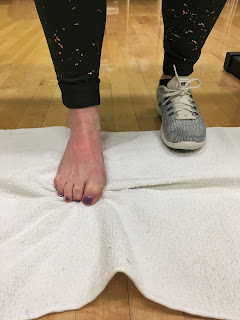Shin splints are a painful condition caused by microtears of
connective tissue at attachment sites in the tibia (lower leg bone) from
overuse or mechanical stress. Symptoms include
pain and tenderness along the front of the shin (tibia) and when chronic or
severe, may be accompanied by swelling and the presence of ridges or bumps
along the front of the bone.
Muscle weakness, stiffness, and poor alignment of the lower
extremity joints (such as flat feet) and use of non-supportive shoes may predispose
you to developing shin splints particularly if training or activity is accelerated
too quickly, you walk/run on hard, ramped or uneven terrain, or you play a stop
and go high impact sport such as basketball.
Shin splints can side line even the most seasoned athlete.
To prevent and treat the condition try the following
exercises. Stretches should be held for
a minimum of 30 seconds to allow time for tissue elongation and to avoid reflex
shortening. Repeat 2-3x, 3x/day. Strengthening should be done 10-20 repetitions
for 2-3 sets daily. Icing, kinesiotaping,
and non-steroidal medications may be helpful in the management of pain. Consult your physical therapist for
assessment and always speak to your doctor before taking any medication.
Stretching
Calf stretch
(gastrocnemius)
Stand upright holding chair or
hands on wall for support with one leg behind you, foot flat and pointed
straight ahead. Keeping back heel down
and knee straight, bend front knee.
Stretch will be felt in calf and Achilles.
Tip: Tighten abdominals and don’t lean forward
with trunk.
Soleus stretch
Stand upright holding chair or with hands on wall for support with one leg
behind you, foot flat and pointed straight ahead. Keeping back heel down, bend BACK knee.
Stretch will be felt in lower part of calf deep under Achilles tendon.
Tip: If you cannot keep your heel down,
shorten your stride.
Toe stretch (toe
flexors and plantar fascia)
Place 2-3” book or small
platform/step against wall. Place toes
against edge of step. Keeping knee straight, lean towards wall. Stretch will be
felt in arch of foot.
Dorsiflexor
stretch (tibialis anterior)
Sit on knees on cushioned surface
with ankles pointing down. Sit back on
heels to stretch front of foot and ankle.
Leaning back with upper body will intensify the stretch.
If unable to
kneel, or if ankles are too tight, sit up with foot crossed in front of you and
use your hand to pull ankle and foot downward.
Strengthening
Ankle
Dorsiflexion (anterior tibialis)
Long sit on
bench or floor. Anchor tubing away from you with loop around foot. Keeping foot and ankle aligned with toes
facing up, flex ankle up towards you to the count of 2, and return down to the
count of 4.
Tip: To maintain proper alignment, keep 2nd toe in line with your shin bone.
Wall Toe Raises
(toe extensors and anterior tibialis)
Stand with back
against wall, feet slightly away and facing forward. Lift toes off ground keeping knees straight.
Hold 5 sec.
Tip: If unable to raise, toes, bring feet a little
further from wall.
Calf Raises
(gastro-soleus)
Stand with feet
shoulder width apart. Go up on toes to count of 2, lower to count of 4.
Challenge yourself by doing on one leg.
Tip: To progress
strengthening through greater range of motion, do off edge of step.
Toe Curls (toe flexors and plantar fascia)
Sit in chair. Place
towel on tile or wood floor. Position
bare foot on towel. Keeping heel down,
curl toes to “scrunch” towel.
Single Leg Bridge
(gluteal muscles)
Lie on your back with knees bent and feet on floor. Straighten one leg keeping thighs in line.
Tighten abdominals and lift hips off ground using bent leg. Keep pelvis
level. Hold 5 sec.
Tip: If too difficult, keep both feet on floor while lifting hips.
Heel to toe
walking
Start in standing position. Step out with
right foot flexing ankle toward you as your foot contacts the ground. Transfer weight to ball of right foot, go up
on toes, then step forward with the left foot contacting heel first with ankle
up. Repeat cycle.
Blog
post by Jody Coluccini PT DPT.
About Jody Coluccini PT DPT
Dr. Coluccini received her Doctorate with distinction from Arcadia
University and her BS in Physical Therapy from Boston University. She brings 39 years of continuous clinical orthopedic, sports and geriatric physical therapy
experience to patient care. Prior to relocating to Cape Cod, Dr. Coluccini
owned a successful private practice in NY and is currently licensed in both New
York and Massachusetts. Jody believes that successful rehabilitation is a
collaborative effort between the therapist and patient achieved by mutual trust
and respect, constant therapeutic reassessment, mutual goal setting and patient
compliance. She understands that being "fit" as one ages or returns
from injury or illness requires a constant modification of goals and activity.









